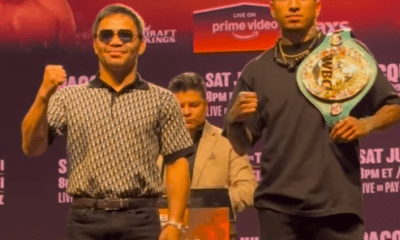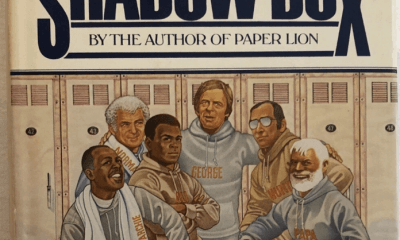Featured Articles
THE PREDICTION PAGE: TEAM TSS Sizes Up Mayweather-Maidana 2
Everyone seems to think “Money” flashes more brilliance, fights smarter and not harder tonight in Vegas, and beats Chino by UD12, sans controversy or aberrant scorecard. Thought: wouldn’t it be something if he lost? Wouldn’t that be great? No, not because there’s enmity there. For the drama. For the change in dynamic. For the anticipation of seeing how such a confident soul reacts when the O goes. If that vaunted undefeated record weren’t there to brag about, if Mayweather got beat with no wiggle room for debate or equivocation, I think that would be great for the sport, for Showtime, who’d get a third Maidana-Mayweather fight, and maybe, maybe for the man himself. He sometimes seem like he could use some grounding.
Let’s see what other TSS keyboard tappers are thinking, and if anyone thinks Chino can be the busier guy in the ring, and do the unthinkable: force Floyd to sip from the bitter chalice of defeat.
DAVID A. AVILA The rematch between Floyd Mayweather and Marcos Maidana will be different for two reasons: 1) Floyd has figured out Maidana’s brawling style and will keep the fight at a distance. 2) Kenny Bayless is the referee and prefers that boxers keep a distance. He disdains inside fighting and hates body shots. There will not be a brawl this time. Bayless will separate them when they even get close to a clinch. Mayweather by decision.
BLAKE HOCHBERGER Mayweather via very tight decision like the last fight. He’s declining fast and losing his legs/ability to evade all opponents’ offense. That said, Maidana isn’t the guy to crack the code.
FRANK LOTIERZO Unless Floyd Mayweather has aged dramatically over the last four months, which I wouldn’t bet on, he’ll win a conclusive decision over Marcos Maidana when they meet for the second time tonight. Maidana was in the last fight but didn’t really come close to actually winning it. He didn’t show me anything over the 12 rounds that the first fight went that he has the needed tools to beat Mayweather. Compete with him, yes, but not defeat him. If Maidana is one of the rare attackers/swarmers who can reinvent himself stylistically and defeat the better skilled boxer/technician in the rematch after losing the first fight, he’ll add his name to a very short list.
AARON LOWINGER Even as one of sport’s most finely-tuned body ages, Floyd Mayweather’s strongest attribute remains his ring acumen. He’s a great defensive fighter, and is able to borrow from his 30 years of experience to make adjustments on the fly. In the first fight, even when Chino was able to pin the master against the ropes, he was rarely able to land anything clean. For Maidana to have a shot, he’ll have to find a way to unnerve Floyd and beat him at his own mental game. It’s counter-intuitive for the Argentine slugger to do anything but brawl, but if he’s smart, he’ll save some power for the late rounds. I don’t think he’s savvy enough to pull it off. Mayweather solved him by round 6 the first time out, I don’t see the second go-round ending any different. Mayweather UD-12
RAYMOND MARKARIAN Will never bet against Floyd until he pulls a Roy Jones one-hitter quitter. Floyd beats Maidana by unanimous decision and moves on to the next.
KELSEY McCARSON Mayweather by UD. I think we see something similar to the same fight this time around, except that we see Maidana a little less successful and Mayweather a little more accurate. It will be entertaining but pretty easy to score. Mayweather is probably the best second-half fighter in the sport. Once he has you figured out, you’re toast. Having gone 12 rounds with Maidana in May, Mayweather will look a lot better early in the fight than he did last time (though Maidana will still have his moments).
JOEL STERN The Mayweather-Maidana II promotion may not have generated much excitement, but Mayweather and Maidana will generate exciting rounds when they step in the ring though not enough for Maidana to earn the victory. Maidana’s jab, timing, ability to see punches coming, unconventional combinations and ability to close distance will continue to trouble Floyd regardless that Floyd has had 12 prior rounds to study Maidana. Floyd will be land the cleaner shots and at times dominate Maidana from the outside and the inside like he did for much of the later half of first fight. I expect Floyd will not be taking multiple steps straight back in this fight and will be turning off much sooner to keep the fight in the center of ring. The open question is can Maidana keep up a maniacal pace for enough rounds to earn a victory. When Maidana is fighting all out, he can still steal the advantage. The other wildcard is Kenny Bayless. Can he keep the fight clean while still allowing Maidana to work when he has Floyd against the ropes? I expect the fight to play out much like the first. With Maidana fading enough for Floyd to dissect him for much of the later half of the fight. 116-112 for Mayweather
AARON TALLENT Maidana seems to be the only person who thinks he won their first matchup. He’ll charge Mayweather again, but be will still be frustrated when the fight ends. Mayweather by unanimous decision.
SPRINGS TOLEDO Maidana looked like something Mayweather can out-speed and counter to death, but looks can be deceiving. Maidana was surprisingly effective last time because he compensates for his slower hand speed by punching with his opponent and getting chest-to-chest and throwing blind shots. His pressure is disruptive and his awkward shots from odd angles are hard to anticipate. Mayweather may claim that he doesn’t watch film, but don’t believe it. He’ll see Maidana’s susceptibility to pull-counters and he’ll feint his way in to invite a Maidana attack, then step back, throw hard ones, and circle out under Maidana’s big hooks. He better stay off the ropes and he better hope that his legs haven’t stiffened with time. I see him using space better, punching harder, and as Maidana fades late, stopping him this time.
MICHAEL WOODS I hope Mayweather loses. For the drama, for the buzz, maybe for the better of him. It seems like his ego is still so thick, that he’s so insulated from reality, that his jail stint didn’t pierce it. Maybe a loss to Maidana would. But unless he overtrained, in taking Chino properly seriously this time, if he didn’t before, and Father Time’s poisonous talons sunk in a millimeter more, we see a UD for Floyd.
PHIL WOOLEVER Have to go with the law of Vegas averages this time. Same fight as before, but easier for Mayweather as Maidana is less effective with his rushes. Mayweather unanimous decision, almost a shutout. Biggest shock could be a flash knockdown by either man. Odds of either guy stepping way up from their performance in the first fight : Mayweather 50% chance, Maidana 10% chance.
Photo credits:Esther Lin/SHOWTIME
-

 Featured Articles3 weeks ago
Featured Articles3 weeks agoAvila Perspective, Chap. 330: Matchroom in New York plus the Latest on Canelo-Crawford
-

 Featured Articles2 weeks ago
Featured Articles2 weeks agoVito Mielnicki Jr Whitewashes Kamil Gardzielik Before the Home Folks in Newark
-

 Featured Articles4 weeks ago
Featured Articles4 weeks agoAvila Perspective, Chap 329: Pacquiao is Back, Fabio in England and More
-

 Featured Articles4 weeks ago
Featured Articles4 weeks agoOpetaia and Nakatani Crush Overmatched Foes, Capping Off a Wild Boxing Weekend
-

 Featured Articles3 weeks ago
Featured Articles3 weeks agoCatching Up with Clay Moyle Who Talks About His Massive Collection of Boxing Books
-

 Featured Articles4 weeks ago
Featured Articles4 weeks agoFabio Wardley Comes from Behind to KO Justis Huni
-

 Featured Articles1 week ago
Featured Articles1 week agoMore Medals for Hawaii’s Patricio Family at the USA Boxing Summer Festival
-

 Featured Articles4 weeks ago
Featured Articles4 weeks agoDelving into ‘Hoopla’ with Notes on Books by George Plimpton and Joyce Carol Oates
















